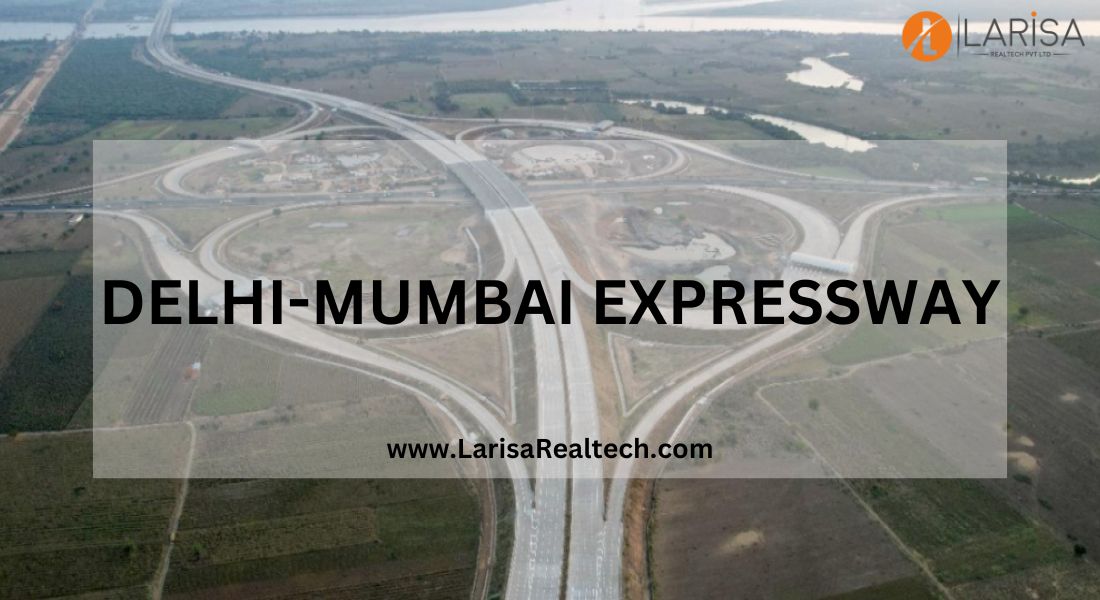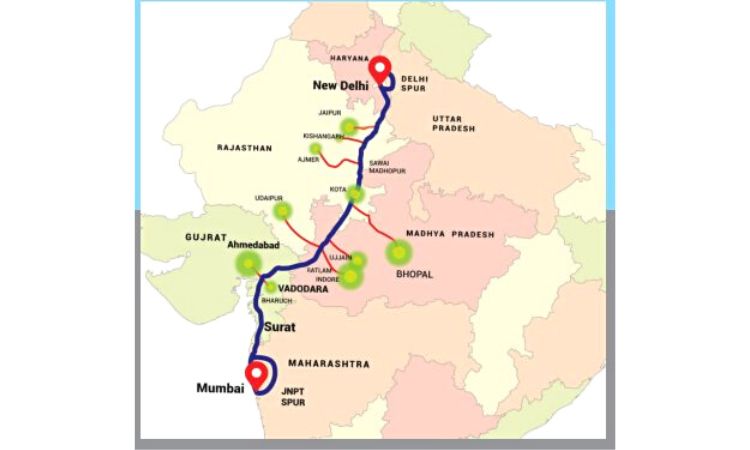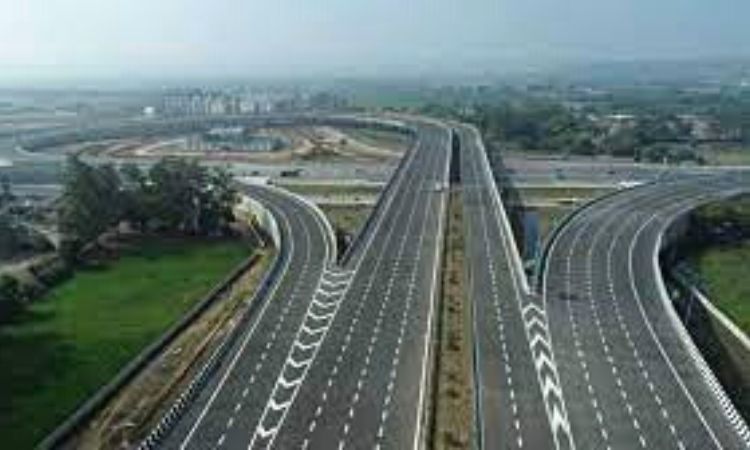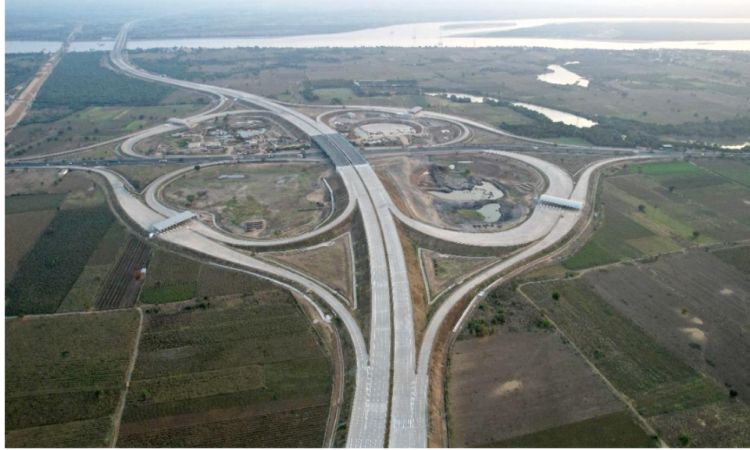
Delhi Mumbai Expressway: Connecting Dreams, Redefining Journeys | A Comprehensive Insight into India’s Gateway of Progress
Delhi Mumbai Expressway is a visionary project of the Central government of India that will connect the two biggest financial cities of the country, i.e., the Financial Capital, Mumbai, and the national capital of India, New Delhi. It will reduce the time taken to travel between Delhi and Mumbai from 24 hours to 12 hours.
This expressway is one of the longest expressways in India, and it is an eight-lane green field expressway; in the future, it can be stretched up to twelve lanes as per traffic. Currently, the Delhi-Mumbai expressway is under construction. This expressway is expected to be completed in the year 2024. The (NHAI) National Highways Authority of India maintains it.
On 12 February 2023, Prime Minister Shri Narendra Modi inaugurated the Sohna-Dausa stretch of the Delhi Mumbai Expressway. Union Ministers Nitin Gadkari, VK Singh, and Gajendra Singh Shekhawat were also present at the inauguration ceremony of this expressway. The Sohna-Dausa stretch has been open to the public since 14 February 2023.
Delhi-Mumbai Expressway Details
On 9 March 2019, the foundation of the Delhi Mumbai Expressway was laid by Union Road and Highway Minister “Shri Nitin Gadkari” on March 2019. It is an eight-lane green field access-controlled expressway totaling 1350 km in length. This 8-lane expressway will reduce the time taken to travel between Delhi and Mumbai from 24 hours to 12 hours.
The route of this expressway will pass through five states, including Maharashtra (171 km), Rajasthan (373 km), Madhya Pradesh (244 km), Gujarat (426 km), and Haryana (129 km).
It will start from Gurgaon in Haryana and pass through Sawai, Madhopur, and Jaipur in Rajasthan. Afterward, the route passes through Ratlam in Madhya Pradesh and Vadodara in Gujarat, ending at Mumbai in Maharashtra. This expressway will perk connectivity to financial hubs like Ajmer, Jaipur, Kota, Udaipur, Kishangarh, Chittorgarh, Bhopal, Indore Ujjain, Ahmedabad, Vadodara, and Surat.
This project will create massive employment for skilled civil engineers and more than fifty lakh workers directly and indirectly. In this expressway, approx. Eighty lakh tons of cement will be utilized to construct this project.
Delhi Mumbai Expressway Route
The route map of Delhi Mumbai expressway has four sections that include different states. Below there is the route alignment for this project:
Section 1: DND-Faridabad-KMP Route:
The Delhi-Mumbai Expressway will start from the Delhi Noida Driveway (DND) flyway in Delhi and other pass-through places like Kalindi Kunj, Okhla, and Shaheen Bagh. It also has an exit and entry point at Sohna in Haryana. The traffic heading from both the exit and entry points will merge at the Kundli-Manesar-Palwal expressway in Nuh, Haryana, and it will move towards Vadodara and Mumbai. This section will cover 9 km in Delhi and 50 km in Haryana.
It will also connect to the upcoming Noida International airport at Jewar. The link road will lead to the Delhi Noida Driveway flyway and the Faridabad-Ballabgarh bypass.
Section 2: Sohna–KMP–Vadodara Route: 845 km
Section two of the Delhi-Mumbai expressway consists of some areas of Haryana like Sohna, Sancholi village, Alipur village, Khalilpur and Bhirawati (Nuh district), Naurangabad, east of Bhadas, east of Ujina, east of Ferozepur Jhirka, west of Pinangwan, and Kolgaon village.
Afterward, this expressway will cross Rajasthan and cover Rajgarh-Mandawar road, east of Dausa, Naugaon village (Alwar district), east of Indragarh, south-west of Lalsot, south-west of Sawai Madhopur, (Bundi), east of Rawatbhata and east of Kota.
This section has a total of 845 km distance and will cover 79 km in Haryana, 373 km in Rajasthan, 244 km in Madhya Pradesh, and 149 km in Gujarat.
Afterward, this project will pass through Madhya Pradesh and covers places such as east of Sitamau, east of Bhanupura, east of Garoth, east of Jaora, west of Ratlam and west of Thandla. After that, the Delhi Mumbai Expressway route will enter Gujarat, where it covers the places such as the north of Dahod, Chhayan Village, some parts of Godhra, Vadodara, and Dodka village.
Section 3: Vadodara–Virar Route
Section 3 of the Delhi-Mumbai Expressway route will pass through various places in Gujarat, including Samiyala & Laxmipura Village, Fajapur Village, Dodka Village, Dehgam Village, Moti Naroli village, east of Valsad and east of Navsari. After that, this Section covers various places on the Gujarat-Maharashtra border and part of Plghar and Virar.
This Section of Delhi Mumbai Expressway route will cover 356 km distance, which covers 277 km in Gujarat and 79 Km in Gujarat.
Section 4: Virar–JNPT Route
This Section will cover 92 km distance in Maharashtra and various places in Maharashtra such as Badlapur, Amane, and Virar, with the Expressway ending at Jawaharlal Nehru Port Trust (JNPT), Mumbai.
Delhi Mumbai Expressway Route Map

Delhi Mumbai Expressway Images
The Union Transport Minister, Mr. Nitin Gadkari, shared a few pictures of this Expressway on Twitter.


Delhi Mumbai Expressway Toll Rates
This Expressway is developing under the Bharatmala Pariyojana. At every 50 km distance, an automatic toll collection system is installed at entry and exit gates. The toll collection system of this Expressway tracks the time and place of entry and withdrawn the toll amount from your Fastag account at the selected exit points.
The estimated toll tax amount for the Sohna-Dausa stretch is approx. Rs. 460, this toll tax calculation is based on Rs.2.19 per km.
Below is the maximum toll amount that can be charged covering the Sohna-Dausa stretch to Barka Pass based, depending on the type of vehicle.
This is one of the longest expressways in India; it has more than 90 exit points due to its length. The Delhi-Mumbai expressway will have the first-ever created an electric lane in India. Toll rates for the remaining section of this expressway will be disclosed soon.
| Types of Vehicles | Maximum Toll Amount |
| Light Vehicles | ₹500 |
| Commercial Vehicles | ₹805 |
| Heavy Vehicles (Trucks or Buses) | ₹1680 |
Delhi Mumbai Expressway Completion Date
As per the reports, the Central Government is trying to complete Delhi Mumbai Expressway by the end of June 2024. Once this Expressway is completed, the travel time between Delhi and Mumbai will be reduced to approx. 12 hours.
The (NHAI) National Highway Authority of India has invited bids for this project’s (ATMS) Advanced Traffic Management System. The National Highway Authority has installed various ATMS equipment across National Highway.
This ATMS will help in the implementation of Intelligent Transport Systems across the highways of the country. It will help enhance the road safety quotient, sustainable, efficient road travel, and stress-free travel.
Distance and Travel Time Between Cities:
Besides reducing travel time between Mumbai and Delhi, the Delhi-Mumbai expressway will also reduce travel time between Jaipur and Delhi. With a sector of the Expressway set to open in March, it will connect to various cities like Udaipur, Kota Jaipur, Chittorgarh, Ujjain, Indore, Ahmedabad, Surat, and Vadodara.
This route will also have several restaurants, food courts, fuel stations, and a heliport for emergency evacuation through air ambulance. This Expressway will have a maximum speed of 120 km per hour.
In Madhya Pradesh, it will connect cities like Jhabua, Mandsaur, and Ratlam. In Rajasthan, the Expressway will touch cities like Bharatpur, Dausa, Kota, Bundi, Tonk, and Alwar. This project will save annually 12 liters of fuel.
Delhi Mumbai Expressway Cost
As per the reports, the construction cost of the Delhi-Mumbai Expressway is approx. Rs 1,00,000 crore, which also includes land ownership costs. This Expressway is constructed as per the Bharat Mala Pariyojna Phase-1 plan.
According to the statement of government officials, a 1200 km road out of 1380 km has been awarded, and the remaining part is under construction. The Government has developed this project in 52 construction packages.
The (NHAI) National Highway Authority of India has formed an (SPV) Special Purpose Vehicle to finance the operation and construction of this project. According to the recent statement from National Highway Authority Of India, this expressway has received AAA ratings from CARE, CRISIL, and India Ratings.
According to the National Highway Authority of India, DMEDL has raised around Rs 9731 crore to fund the expressway project partially. The SBI Bank has raised the fund of 5000 crores for this e-way. Further significant investors in the DMEDL are the Bank of Maharashtra, Punjab National Bank and Axis Bank.
There will be a 160 Km stretch of this Expressway that will pass through Haryana and be constructed at approx. 10,400 crores. According to the government, this stretch will benefit approx. 73 villages. As per the Union Ministry, the Mumbai-Delhi Expressway will help reduce 27% of vehicular pollution in Delhi-NCR.
It will cover a stretch of 375 km in Rajasthan, constructed with more than ₹16,600 crores. This stretch of Expressway will pass through various places in Rajasthan, such as Alwar, Kota, Dausai, Bharatpur, and Madhopur.
Also, several bridges will be constructed across the Chambal River, Banganga, and Mezriver River. Currently, most of the bridges are in the under-construction stage, and only some are ready in different states. This Expressway will cover a 250 km area in Madhya Pradesh. The cost of Delhi Vadodara Expressway is ₹8,500 crores.
The project cost includes land acquisition, construction, technology integration, and other associated infrastructure developments. Mumbai Delhi expressway is not just a network of roads but a complete corridor designed to accommodate various amenities such as smart cities, logistics hubs, and green belts, adding to the overall cost.
Mumbai Delhi Expressway Route Highlights
Below there are some highlights of the expressway route.
- This project is one of the longest expressways in India.
- It reduces the travel time from Delhi to Mumbai from 24 to 12 hours.
- The travel time between Mumbai and Delhi will be reduced to half, i.e., from 24 to 12 hours when traveling via Delhi Mumbai Expressway.
- Recently, the Sohna-Dause stretch has been opened, reducing the travel time between Gurgaon to Jaipur by two hours.
- This Expressway will cover six states – Haryana, Rajasthan, Delhi, Gujarat, Maharashtra, and Madhya Pradesh.
- This project has more than 40 interchanging points; the Mumbai Delhi Expressway connects major cities of India like Vadodara, Kota, Jaipur, Surat, Indore, and Bhopal.
- Delhi Mumbai Expressway offers a dedicated corridor for installing solar power generation systems, pipelines, and optical fiber cables.
- This project has more than 2,000 water recharge points with over 94 on-route amenities.
State-Wise Route Length of Delhi Mumbai Expressway
This expressway will pass through five major states, including Maharashtra, Haryana, Rajasthan, Madhya Pradesh, and Gujarat. Here is the state-wise length of the Mumbai-Delhi Expressway route.
|
States |
Length |
|
Maharashtra |
120 km |
|
Haryana |
80 Km |
| Rajasthan |
380 Km |
| Madhya Pradesh |
370 Km |
| Gujarat |
300 Km |
Real Estate Opportunities: Mumbai Delhi Expressway
Overall Real Estate Growth: This project is one of the most prestigious of the Indian Government; it has great potential for robust development in commercial properties, townships, and housing projects. More than 70% of the work on this expressway has been completed. It will boost the Indian real estate market.
This expressway is one of the most significant highway projects in India. It will help drive organized business and investments into logistics parks, business parks, townships, and more. The small villages or towns around Surat, Vadodara, and Ahmedabad, like Bharuch, Valsad, and Panchmahal, are also likely to get a push with increased economic activity.
Increase in Land Prices: Property prices have increased by 60 to 70% in the last three years. The growth of big projects, including those by Godrej, Signature Global, and other established builders, is even higher. Especially in Gurgaon, the Sohna-Dausa section has boomed in the real estate market.
Earlier, the prices in these areas were around Rs 90,000 to Rs 1,000,000 per square yard. But today, after just 2 to 3 years, the price is around Rs 1,40,000 to Rs 1,60,000 per square yard in the area. In addition, the prices for apartments are also likely to increase significantly in regions around the Delhi-Mumbai Expressway.
The land cost is also expected to go up around the Jawaharlal Nehru Port Trust (JNPT) area by around 30 to 40 percent.
Sohna to Become a new Real Estate Area: With the opening of this expressway, Sohna might become a new real estate hotspot in Haryana. The expressway will pass through Rajasthan, Haryana, Gujarat, Madhya Pradesh, and Maharashtra. Thus, the project will help attract more investors to the city.
Also, government has construct various sectors around (NH-248A) Delhi-Alwar Expressway and Dwarka Expressway. According to believes of Real estate experts Sohna is centrally located in the Delhi-NCR and is well connected to many other cities.
READ ON: TOP 5 Upcoming Affordable Housing Projects in Gurgaon-Sohna 2024
The real estate growth of any town largely depends on the connectivity and physical and social infrastructure of the locality. Other factors responsible for development are residential and commercial developments in the neighborhood.
According to the data shared by the DTCP (Department of Town and Country Planning), there are 19 group housing projects in Sohna, six to seven commercial projects, ten affordable group housing projects, and 15 projects under the Deen Dayal Awas Yojana.
With the opening of the Sohna-Dahusa section on the Delhi-Mumbai Expressway, the number of real estate opportunities is likely to increase. After the fully operational of the expressway, these opportunities will further increase.
This project will improve connectivity and reduce travel times, which are likely to cause a surge in industrial growth, especially in logistics and warehousing. It will directly give real estate benefits to 26 districts, 11 of which are in Maharashtra and Gujarat.
Delhi Mumbai Expressway Rules
NHAI makes several rules and regulations for Mumbai Delhi Expressway; if you travel this e-way, you must follow these rules.
- The Delhi Mumbai Expressway’s maximum speed limit is 120 km/h.
- You can not stop your vehicle on the Mumbai Delhi Expressway because it is a high-speed corridor, which may be risky.
- Two or three-wheelers like auto-rickshaws, bikes, tractors, bullock carts, and trollies cannot enter this expressway. If two or three-wheelers enter this expressway, they must pay a fine of ₹5000.
- It is a dream project of Shri Nitin Gadkari, Union Minister, and Delhi Mumbai expressway will be completed by June 2024.
- The toll gates of this expressway are located at Barakapara, Durgapur, Khalipur, Shamshabad, , and Pinan.
Delhi Mumbai Expressway: Conclusion
The Delhi-Mumbai Expressway is a game-changer project for the Indian economy. This expressway will save lots of time and fuel, which will ultimately help boost the economy.
It is the first time in any expressway in India with a dedicated lane for electric vehicles. This expressway is an 8-lane greenfield road that can be expanded to 12 lanes. The total length of this expressway is 1350 km. It will pass through various cities like Mumbai, Virar, Navsari, Valsad, Bharuch, Surat, Dahod, Ratlam, Mandsur, Kota, Sohna, Alwar, Dausa, Alwar and Sohna.
As per the sources, the Delhi-Mumbai Expressway Completion Date will be completed by June 2024. Also, it is the first expressway in India to have 5 animal bridges. A 4km long tunnel will be in this e-way, passing from the Matheran eco-sensitive zone and Mukundara National Park.
READ ON: Low Rise Apartments in Gurgaon
FAQs
What are the total cost of the Delhi Mumbai Expressway?
Approx. ₹1,00,000 was used in the construction of the Delhi Mumbai Expressway Project.
Which states does the Delhi-Mumbai Expressway route pass through?
This Expressway will go through Haryana, Gujarat, Rajasthan, Madhya Pradesh, and Maharashtra.
How long is Delhi to Mumbai Expressway?
It has a total 1350 km distance from Delhi to Mumbai.
Which national highway connects Delhi and Mumbai?
NH-48 will connect Delhi & Mumbai
When will the Delhi-Mumbai Expressway project be completed?
It is expected this project will be completed by June 2024
Which main points does the Delhi-Mumbai Expressway connect?
This Expressway will connect Delhi, Delhi-Noida-Direct Flyway, with Jawaharlal Nehru Port, Mumbai.
Where would the Delhi-Mumbai Expressway start?
It will start from the Delhi-Noida-Delhi flyway in Delhi, passing through various locations and localities, including Kalindi Kunj, Shaheen Bagh, Okhla, and more.
What is the current construction status of the Delhi Mumbai Expressway?
This project is expected to complete by 2024, and more than 70% work has been completed.
Who is funding Delhi Mumbai Expressway?
This expressway funding by the National Highways Authority of India.
Which place is the starting point of the Delhi-Mumbai Expressway?
The starting point of this Expressway is Gurgaon.
Is the Delhi-Mumbai Expressway open?
The Delhi-Sohna-Dausa Stretch is open, and the remaining part will be available by June 2024.
How much time will it take from Delhi to Mumbai by the new Expressway?
It will take 12 hours from Delhi to Mumbai by the new Expressway.
What are Delhi Mumbai Expressway toll charges?
The estimated toll amount for the Sohna-Dausa stretch on Delhi Mumbai Expressway is Rs.2.19 per km. The maximum toll amount that can be charged on the distance to Barka Pass is Rs.500, Rs.805, and Rs.1680 for cars, commercial vehicles, and heavy vehicles, respectively.
What is the speed limit allowed on the Delhi Mumbai Expressway?
The speed limit allowed on the Delhi Mumbai Expressway is 120 km/hr.
When was the Delhi Mumbai Expressway inaugurated?
The first Phase was open by February 23, 2023.
What are the facilities available on the Delhi Mumbai Expressway Project?
This Expressway offers various facilities such as food courts, ATMs, hotels, single-brand food stores such as Mc Donalds, Subway, Burger King, etc., fuel stations, retail shops, and charging stations designed for electric vehicles available on this Expressway.



